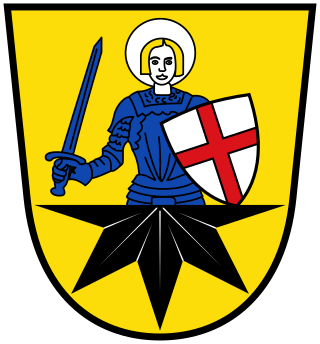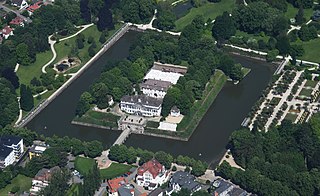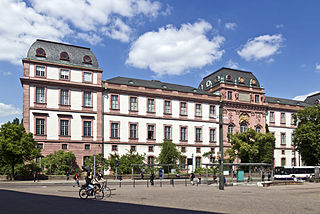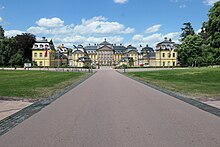
Emma of Waldeck and Pyrmont was Queen of the Netherlands and Grand Duchess of Luxembourg as the wife of King-Grand Duke William III. An immensely popular member of the Dutch Royal Family, Queen Emma served as regent for her daughter, Queen Wilhelmina, during the latter's minority from 1890 until 1898.

The County of Waldeck was a state of the Holy Roman Empire and its successors from the late 12th century until 1929. In 1349 the county gained Imperial immediacy and in 1712 was raised to the rank of principality. After the dissolution of the Holy Roman Empire in 1806 it was a constituent state of its successors: the Confederation of the Rhine, the German Confederation, the North German Confederation, and the German Empire. After the abolition of the monarchy in 1918, the renamed Free State of Waldeck-Pyrmont became a component of the Weimar Republic until divided between Hannover and other Prussian provinces in 1929. It comprised territories in present-day Hesse and Lower Saxony (Germany).
Waldeck-Frankenberg is a Kreis (district) in the north of Hesse, Germany. Neighbouring districts are Höxter, Kassel, Schwalm-Eder, Marburg-Biedenkopf, Siegen-Wittgenstein, Hochsauerland.

Bad Arolsen is a small town in northern Hesse, Germany, in Waldeck-Frankenberg district. From 1655 until 1918 it served as the residence town of the Princes of Waldeck-Pyrmont and then until 1929 as the capital of the Waldeck Free State. The International Tracing Service has its headquarters in Bad Arolsen.

Waldeck is a small town in Waldeck-Frankenberg district in northwestern Hesse, Germany. Its located near the Edersee, which is a popular destination for tourists and locals alike.

Friedrich, Prince of Waldeck and Pyrmont was the last reigning Prince of Waldeck and Pyrmont from 12 May 1893 to 13 November 1918.

Wittekind Adolf Heinrich Georg-Wilhelm, Prince of Waldeck and Pyrmont has since 1967 been the head of the House of Waldeck and Pyrmont.

Mengeringhausen is a village and a municipal district of Bad Arolsen in Waldeck-Frankenberg, in Hesse, Germany. Its population is estimated to be 3,800 people. It was first mentioned as the town 'Stadt Mengeringhausen' in 1234. The town was in possession of sovereign principality Waldeck.

Christiane Henriette of Palatinate-Zweibrücken-Birkenfeld was a Countess of Palatine of Zweibrücken-Birkenfeld by birth and by marriage a Princess of Waldeck-Pyrmont.

Count Wolrad IV 'the Pious' of Waldeck-Eisenberg, German: Wolrad IV. 'der Fromme' Graf von Waldeck-Eisenberg, official titles: Graf zu Waldeck und Pyrmont, was since 1588 Count of Waldeck-Eisenberg. He founded of the new line of Waldeck-Eisenberg.

Schaumburg Castle is a schloss in Rhineland-Palatinate, Germany, south of Balduinstein near Limburg an der Lahn.

Count Christian of Waldeck-Wildungen, German: Christian Graf von Waldeck-Wildungen, official titles: Graf zu Waldeck und Pyrmont, was since 1588 Count of Waldeck-Eisenberg and after the division with his brother in 1607 Count of Waldeck-Wildungen. He founded the new cadet branch of Waldeck-Wildungen and is the progenitor of the princes of Waldeck and Pyrmont.

Count Josias I of Waldeck-Eisenberg was a German nobleman who was Count of Waldeck-Eisenberg from 1578 until his death.

Count Josias II of Waldeck-Wildungen, German: Josias II. Graf von Waldeck-Wildungen, official titles: Graf zu Waldeck und Pyrmont, Herr zu Tonna, was since 1660 Count of Waldeck-Wildungen. However, he was primarily a military man.

Schloss Weimar is a Schloss (palace) in Weimar, Thuringia, Germany. It is now called Stadtschloss to distinguish it from other palaces in and around Weimar. It was the residence of the dukes of Saxe-Weimar and Eisenach, and has also been called Residenzschloss. Names in English include Palace at Weimar, Grand Ducal Palace, City Palace and City Castle. The building is located at the north end of the town's park along the Ilm river, Park an der Ilm. It forms part of the World Heritage Site "Classical Weimar", along with other sites associated with Weimar's importance as a cultural hub during the late 18th and 19th centuries.

Schloss Pyrmont, sometimes called Pyrmont Castle, was a schloss and the summer residence of the counts of Spiegelberg and counts of Waldeck-Pyrmont in the present-day German town of Bad Pyrmont. The current building dates to the 18th century and houses a museum. The schloss is part of Pyrmont Fortress which dates to the 16th century.

The Dessau Palace in Dessau in the German state of Saxony-Anhalt was a princely palace which mostly served as the main residence of the princes of Anhalt-Dessau and later the Dukes of Anhalt. The palace was one of the first renaissance buildings in the middle of Germany. Today, there is only one wing remaining, the Johannbau, which offers room to the City History Museum of Dessau.

The Residential Palace Darmstadt is the former residence and administrative seat of the landgraves of Hesse-Darmstadt and from 1806 to 1919 of the Grand Dukes of Hesse-Darmstadt. It is located in the centre of the city of Darmstadt. The palace consists of an older Renaissance part and an 18th century Baroque part.
Johann Heinrich Jakob Roth was a German master builder of the 18th century.

Countess Wilhelmine Christine of Nassau-Siegen, German: Wilhelmine Christine Gräfin von Nassau-Siegen, official titles: Gräfin zu Nassau, Katzenelnbogen, Vianden und Diez, Frau zu Beilstein, was a countess from the House of Nassau-Siegen, a cadet branch of the Ottonian Line of the House of Nassau, and through marriage Countess of Waldeck-Wildungen.


















